theartsdesk in Fårö: Bergman's Swedish Dream Island | reviews, news & interviews
theartsdesk in Fårö: Bergman's Swedish Dream Island
theartsdesk in Fårö: Bergman's Swedish Dream Island
The midsummer sun beats down on the great director's place of nightmares and catharsis
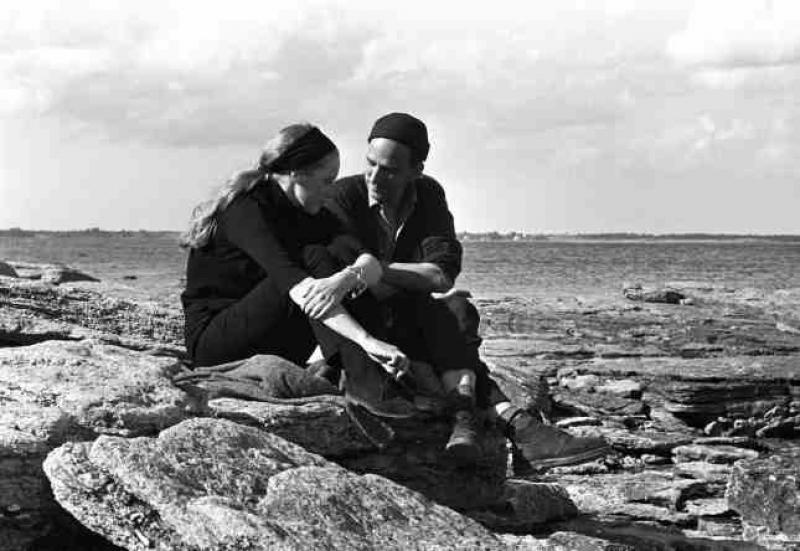
Fifty years ago this April, a city-loving film-maker already internationally famous for such masterpieces as The Seventh Seal and Wild Strawberries took the ferry from Gotland to the windswept, still snowy island of Fårö (the nearest we can get in terms of pronounciation might be "Four-er").
This was the tenth such week, which means they've been going since before Bergman's death at the age of 89 in July 2007. One celebrity visitor during the great man's lifetime was Ang Lee: Bergman apparently told him The Ice Storm was a "total masterpiece" but seems to have thought differently about it off the record. For 2010, there was a whole clutch of distinguished special guests. As part of a group of eight international journalists - Indian, Chinese, Russian, German, American and English - I missed several of them: we arrived too late to catch Bergman's set designer Anna Asp and more than a glimpse of the beautiful Lena Endre, star of Liv Ullmann's film about Bergman's extra-marital affair Faithless, and left before the advent of Ariane Mnouchkine, legendary leader of the Théâtre du Soleil.
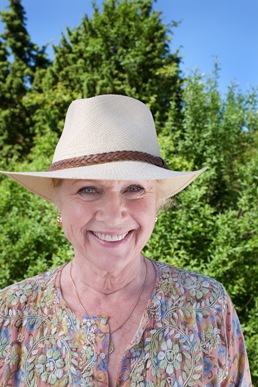 We were there, however, to witness the emotional return of Ullmann herself (pictured right by Peter Assar Monsan for Bergman Week). She hadn't been back since the funeral, and in conversation with Jannike Ahlund shed a few emotional tears. Asked what the whole experience, from Persona to living with and later visiting Bergman at his Hammars home, meant to her, she said, "It's still now - it's not over, it's part of who I am. Some things are fading and others are starting to live and be real." Like everyone who knew and sometimes suffered at his hands, she's at pains to point out what fun he could be during filming, recalling his playfulness during Faithless when he hid in the bed where Lena Endre's character discovers her lover.
We were there, however, to witness the emotional return of Ullmann herself (pictured right by Peter Assar Monsan for Bergman Week). She hadn't been back since the funeral, and in conversation with Jannike Ahlund shed a few emotional tears. Asked what the whole experience, from Persona to living with and later visiting Bergman at his Hammars home, meant to her, she said, "It's still now - it's not over, it's part of who I am. Some things are fading and others are starting to live and be real." Like everyone who knew and sometimes suffered at his hands, she's at pains to point out what fun he could be during filming, recalling his playfulness during Faithless when he hid in the bed where Lena Endre's character discovers her lover.
Actually we irreverent eight had a running gag about "Ingmar - but he was such a playful guy". Well, he was, as anyone who knows the films in the round will know. But he could also be, in his own words, a complete shit. It doesn't sound like huge fun as Liv described it being his companion at Hammars. She wasn't allowed to see other people, to make friends on the island. And visiting Hammars, as only the privileged few are allowed to do, reinforced that essentially this is still a bachelor's home: all those women who lived there, his last wife Ingrid the longest of all, seem not to have made much of a feminine dent on a collector's hermitage. It's like one giant shed-retreat, with rooms devoted to videos - towards the end of his life Bergman rejected DVDs - books and records.
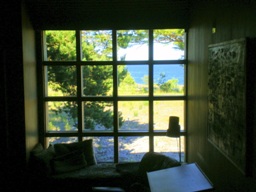 That we could still see it all is another little miracle. Last year the entire contents of Hammars were put up for auction. The Ingmar Bergman Foundation, one of three seemingly harmonious institutions guarding the interests of the master, had hoped to pick up the few items they could afford, only to be outbid: it was clear that one man wanted everything. He got it, but Norwegian multi-millionaire Hans Gude Gudesen then returned everything to Hammars. It's a living, breathing home, as simple as the Sibelius house I visited earlier this year in Finland. A long, low ranch that, like Topsy, just growed, its wide windows give more of a view of pines than they do of the sea, which is how IB wanted it: trees were always the most important symbols of nature for him. But in the study, where the main desk is below a small, high window with no chance of a distraction from the day's work, there's also a bay with a bigger outlook (pictured above) where you can see the sea.
That we could still see it all is another little miracle. Last year the entire contents of Hammars were put up for auction. The Ingmar Bergman Foundation, one of three seemingly harmonious institutions guarding the interests of the master, had hoped to pick up the few items they could afford, only to be outbid: it was clear that one man wanted everything. He got it, but Norwegian multi-millionaire Hans Gude Gudesen then returned everything to Hammars. It's a living, breathing home, as simple as the Sibelius house I visited earlier this year in Finland. A long, low ranch that, like Topsy, just growed, its wide windows give more of a view of pines than they do of the sea, which is how IB wanted it: trees were always the most important symbols of nature for him. But in the study, where the main desk is below a small, high window with no chance of a distraction from the day's work, there's also a bay with a bigger outlook (pictured above) where you can see the sea.
It's fascinating, of course, to see what's in the library and the video collection, though obviously many of the items were unwatched or unread gifts. I was tickled to see Anger Management alongside All About Eve, The Asphalt Jungle and Ansiktet (The Face or The Magician, one of Bergman's underrated masterpieces and perhaps my personal favourite). A first edition piano score of Rubinstein's opera The Demon is among the scores in the library; Bergman's own personal demons pop out in a devilish injunction to switch off a light and the astonishing bedside table on which he jotted down many of his dreams and nightmares while he could still remember them (pictured below right).
 The whole place still lets fresh artistic air in by inviting visiting creative artists who need a quiet place to think and work. Heading the scheme is the delightful Linn Ullmann, Liv's daughter and putative favourite of Bergman's nine children. Her deservedly acclaimed novel A Blessed Child, which I'm beginning to read, starts with transfigured autobiography: "Isak was 84 years old and lived by himself in a white limestone house on Hammarsö, an island off the east coast of Sweden." Swap limestone for wood, and you have a snapshot of Ingmar at Hammars.
The whole place still lets fresh artistic air in by inviting visiting creative artists who need a quiet place to think and work. Heading the scheme is the delightful Linn Ullmann, Liv's daughter and putative favourite of Bergman's nine children. Her deservedly acclaimed novel A Blessed Child, which I'm beginning to read, starts with transfigured autobiography: "Isak was 84 years old and lived by himself in a white limestone house on Hammarsö, an island off the east coast of Sweden." Swap limestone for wood, and you have a snapshot of Ingmar at Hammars.
The links become even clearer when the novelist tells us that his appearance "suggested the beginnings of a rauk, one of those four-hundred-million-year-old island outcrops in the sea , so characteristic of Hammerso". And indeed, those spellbinding rauks are certainly characteristic of Fårö. It was their appearance which first excited Bergman with the prospect of filming Through a Glass Darkly here, though in fact the final exchange between father and son, originally filmed on the beach at Langhammars (pictured below), had to be remade in the specially built house since the rauks took the eye too much away from the human beings.
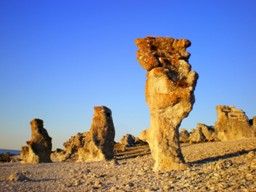 Linn met and greeted us at what was for me the most awe-inspiring slice of Bergmania we encountered: the barn near Hammars at Dämba which was first converted into the interiors for Scenes from a Marriage - the nearby farmhouse with windmill was used for the outside shots- and then a private cinema and cutting room. There what I firmly believe to be the greatest operatic film ever made, The Magic Flute, was premiered. Linn was there - Bergman had even wanted her to be the face of the little girl who sits rapt during the Overture, but her mother was firm that she had school to go to. She recalled how more casual screenings would take place at three pm in the afternoon. Everyone would gather and some would sit on the wooden bench outside the cinema before the showing - anything from classic silents, Swedish and otherwise, to the latest Hollywood film.
Linn met and greeted us at what was for me the most awe-inspiring slice of Bergmania we encountered: the barn near Hammars at Dämba which was first converted into the interiors for Scenes from a Marriage - the nearby farmhouse with windmill was used for the outside shots- and then a private cinema and cutting room. There what I firmly believe to be the greatest operatic film ever made, The Magic Flute, was premiered. Linn was there - Bergman had even wanted her to be the face of the little girl who sits rapt during the Overture, but her mother was firm that she had school to go to. She recalled how more casual screenings would take place at three pm in the afternoon. Everyone would gather and some would sit on the wooden bench outside the cinema before the showing - anything from classic silents, Swedish and otherwise, to the latest Hollywood film.
Imagine if you can the awe of a Bergman fan at being admitted into this holiest of holies and treated to a whole series of private screenings. There are only 15 extremely comfortable seats, and the master's is the one with the cushion on it (second from the left, pictured below). And just to prove that this was no museum, Pia Lundberg of the Swedish Film Institute had lined up for us four films so fresh off the press, as it were, that we can't even tell you what they were yet. Suffice it to say that two were excellent, two starred the latest Skarsgård to make a splash, charismatic young Bill - only one of them, by the way, making the first category - and that if the luminous Alicia Vikander doesn't walk off with a clutch of awards, I'd be very surprised. By the way, the one film to meet with the most success in terms of festival selection so far we all unanimously thought a stinker.
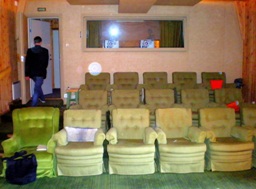 Bergman films were being screened, in fact, at the slightly larger theatre at Sudersand. We were there, it seems, for the final performances: the barn is up for sale and will probably become yet another Swedish holiday home. It was hot and bothersome there in the afternoon, so I skipped seeing a comic masterpiece, Smiles of a Summer Night, on our first full evening and went for a walk to see the oak at Ava beneath which Linnaeus sat during a specimen-collecting expedition along the south coast, before capturing my own smiles of midsummer along the beach back to Sudersand.
Bergman films were being screened, in fact, at the slightly larger theatre at Sudersand. We were there, it seems, for the final performances: the barn is up for sale and will probably become yet another Swedish holiday home. It was hot and bothersome there in the afternoon, so I skipped seeing a comic masterpiece, Smiles of a Summer Night, on our first full evening and went for a walk to see the oak at Ava beneath which Linnaeus sat during a specimen-collecting expedition along the south coast, before capturing my own smiles of midsummer along the beach back to Sudersand.
What I did see in the Sudersand Cinema was the second instalment of Stig Björkman's impressionistic films selecting behind-the-scenes footage from Bergman movies. ...but Film is My Mistress I have to say I liked less than the charming first, not least because this time we were given very truncated scenes from the films in question (though the incredible, ultimately fruitful on-set tension between Bergmans Ingmar and the dying Ingrid in Autumn Sonata made for compelling viewing). It was, on the other hand, a real privilege to see the second of Bergman's films about the island and the islanders he loved and respected so much, the second Fårö Document of 1979, with its painstaking lengthy sequences of sheep-shearing and pig-slaughter. Chastening to think that since the documentary was made, the two schools have closed down, only a handful of farmers remain and the fishermen, already coping back then with a depleted Baltic, have given up. The statistics say it all: around 500 islanders and 11,000 summer visitors.
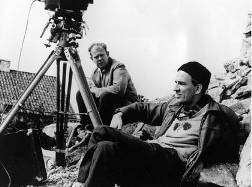 Not that the visitors are ever, at least in late June, overwhelming; there's only a handful of places to stay if you don't have a summer home, and the journalists were walled up two each in brand new, rather odd but thankfully mosquito-proof little capsules on the Sudersand campsite where Bergman, his cinematographer Sven Nykvist (pictured left with Bergman during the filming of Through a Glass Darkly) and the cast also stayed before he became a resident.
Not that the visitors are ever, at least in late June, overwhelming; there's only a handful of places to stay if you don't have a summer home, and the journalists were walled up two each in brand new, rather odd but thankfully mosquito-proof little capsules on the Sudersand campsite where Bergman, his cinematographer Sven Nykvist (pictured left with Bergman during the filming of Through a Glass Darkly) and the cast also stayed before he became a resident.
Our assiduous if completely relaxed hosts made sure we saw as much of Fårö as possible. Not for nothing is Kutens Bensin, a creperie filled with Fifties memorabilia and a stage for happening music events, a major attraction on the island. Its remarkable owner, who loves what he's built up, describes it on the wacky website as a "joint venture between the impossible and the unbelievable". His daughter, who lived in France for many years and studied with a cordon bleu chef, served us up with some of the best baking and sandwiches I've ever tasted for our lunches between screenings at Dämba; but there's no substitute for having a crepe at the place itself.
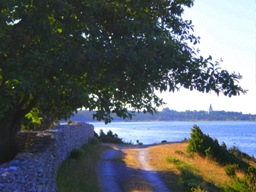 And then, last but not least, there was the Big Coach Tour of Bergman's Fårö, starting from the Bergman Centre in the former school near the island's only church. It was a necessary evil - I hate sitting on coaches with the tour guide narrating - because many of the key beaches are reachable only through private property (though it seems that, after the demise of Bergmanland with its barbed wire fences, keep-out signs and terrible dachshund guardian, there are few no-go areas and anyone can camp a night or two on a private beach according to Swedish law). Our "film safari", led by a nice lady from Gotland Film, took us first to the territory of Through a Glass Darkly and Persona, with DVDs set up in the backs of vans on site so we could compare Harriet, Gunnar and Max arriving by boat and Liv and Bibi running along the beach with our own experience (the wall behind which the house of Through a Glass Darkly was built, with Fårö Church in the distance, pictured above right).
And then, last but not least, there was the Big Coach Tour of Bergman's Fårö, starting from the Bergman Centre in the former school near the island's only church. It was a necessary evil - I hate sitting on coaches with the tour guide narrating - because many of the key beaches are reachable only through private property (though it seems that, after the demise of Bergmanland with its barbed wire fences, keep-out signs and terrible dachshund guardian, there are few no-go areas and anyone can camp a night or two on a private beach according to Swedish law). Our "film safari", led by a nice lady from Gotland Film, took us first to the territory of Through a Glass Darkly and Persona, with DVDs set up in the backs of vans on site so we could compare Harriet, Gunnar and Max arriving by boat and Liv and Bibi running along the beach with our own experience (the wall behind which the house of Through a Glass Darkly was built, with Fårö Church in the distance, pictured above right).
Only in Bergman Week would you "have a chance to act on location in a Bergman film when we reconstruct a scene from Shame". And who was reluctantly pulled from the crowd to play a second Max von Sydow towing his remaining worldly goods in a cart in front of an equally unfortunate female playing the Liv Ullmann role? You guessed it. My attempts at conveying utter exhaustion, even though I was beginning to feel it under the relentless sun after a full day, did not transmit to screen.
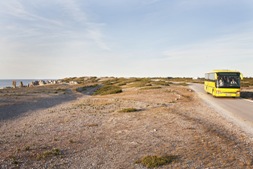 So much for the horror. The pay-off came as the coach (pictured left by Peter Assar Monsan) drove us north to munch on lamb burgers and wander off among the rauks of Langhammars, casting their long shadows in the late evening light. Whether or not it's true that the rocks and stones, with their fossilised remains of coral reef, really detached from Africa millennia ago, there's no stranger place on earth. And you may be glad to know that all eight journalists are already thinking of ways - shepherding, gardening, conferencing - of returning next year to Prospero Bergman's enchanted island.
So much for the horror. The pay-off came as the coach (pictured left by Peter Assar Monsan) drove us north to munch on lamb burgers and wander off among the rauks of Langhammars, casting their long shadows in the late evening light. Whether or not it's true that the rocks and stones, with their fossilised remains of coral reef, really detached from Africa millennia ago, there's no stranger place on earth. And you may be glad to know that all eight journalists are already thinking of ways - shepherding, gardening, conferencing - of returning next year to Prospero Bergman's enchanted island.
- Keep an eye on the Bergmanveckan website for details of Bergman Week 2011
- Bille August's film of Bergman's screenplay about his parents, The Best Intentions, reviewed on theartsdesk
All colour images by David Nice except where otherwise stated
Explore topics
Share this article
The future of Arts Journalism
You can stop theartsdesk.com closing!
We urgently need financing to survive. Our fundraising drive has thus far raised £49,000 but we need to reach £100,000 or we will be forced to close. Please contribute here: https://gofund.me/c3f6033d
And if you can forward this information to anyone who might assist, we’d be grateful.

Subscribe to theartsdesk.com
Thank you for continuing to read our work on theartsdesk.com. For unlimited access to every article in its entirety, including our archive of more than 15,000 pieces, we're asking for £5 per month or £40 per year. We feel it's a very good deal, and hope you do too.
To take a subscription now simply click here.
And if you're looking for that extra gift for a friend or family member, why not treat them to a theartsdesk.com gift subscription?
more Film
 Bugonia review - Yorgos Lanthimos on aliens, bees and conspiracy theories
Emma Stone and Jesse Plemons excel in a marvellously deranged black comedy
Bugonia review - Yorgos Lanthimos on aliens, bees and conspiracy theories
Emma Stone and Jesse Plemons excel in a marvellously deranged black comedy
 theartsdesk Q&A: director Kelly Reichardt on 'The Mastermind' and reliving the 1970s
The independent filmmaker discusses her intimate heist movie
theartsdesk Q&A: director Kelly Reichardt on 'The Mastermind' and reliving the 1970s
The independent filmmaker discusses her intimate heist movie
 Blu-ray: Wendy and Lucy
Down-and-out in rural Oregon: Kelly Reichardt's third feature packs a huge punch
Blu-ray: Wendy and Lucy
Down-and-out in rural Oregon: Kelly Reichardt's third feature packs a huge punch
 The Mastermind review - another slim but nourishing slice of Americana from Kelly Reichardt
Josh O'Connor is perfect casting as a cocky middle-class American adrift in the 1970s
The Mastermind review - another slim but nourishing slice of Americana from Kelly Reichardt
Josh O'Connor is perfect casting as a cocky middle-class American adrift in the 1970s
 Springsteen: Deliver Me From Nowhere review - the story of the Boss who isn't boss of his own head
A brooding trip on the Bruce Springsteen highway of hard knocks
Springsteen: Deliver Me From Nowhere review - the story of the Boss who isn't boss of his own head
A brooding trip on the Bruce Springsteen highway of hard knocks
 The Perfect Neighbor, Netflix review - Florida found-footage documentary is a harrowing watch
Sundance winner chronicles a death that should have been prevented
The Perfect Neighbor, Netflix review - Florida found-footage documentary is a harrowing watch
Sundance winner chronicles a death that should have been prevented
 Blu-ray: Le Quai des Brumes
Love twinkles in the gloom of Marcel Carné’s fogbound French poetic realist classic
Blu-ray: Le Quai des Brumes
Love twinkles in the gloom of Marcel Carné’s fogbound French poetic realist classic
 Frankenstein review - the Prometheus of the charnel house
Guillermo del Toro is fitfully inspired, but often lost in long-held ambitions
Frankenstein review - the Prometheus of the charnel house
Guillermo del Toro is fitfully inspired, but often lost in long-held ambitions
 London Film Festival 2025 - a Korean masterclass in black comedy and a Camus classic effectively realised
New films from Park Chan-wook, Gianfranco Rosi, François Ozon, Ildikó Enyedi and more
London Film Festival 2025 - a Korean masterclass in black comedy and a Camus classic effectively realised
New films from Park Chan-wook, Gianfranco Rosi, François Ozon, Ildikó Enyedi and more
 After the Hunt review - muddled #MeToo provocation
Julia Roberts excels despite misfiring drama
After the Hunt review - muddled #MeToo provocation
Julia Roberts excels despite misfiring drama
 Ballad of a Small Player review - Colin Farrell's all in as a gambler down on his luck
Conclave director Edward Berger swaps the Vatican for Asia's sin city
Ballad of a Small Player review - Colin Farrell's all in as a gambler down on his luck
Conclave director Edward Berger swaps the Vatican for Asia's sin city
 London Film Festival 2025 - Bradley Cooper channels John Bishop, the Boss goes to Nebraska, and a French pandemic
... not to mention Kristen Stewart's directing debut and a punchy prison drama
London Film Festival 2025 - Bradley Cooper channels John Bishop, the Boss goes to Nebraska, and a French pandemic
... not to mention Kristen Stewart's directing debut and a punchy prison drama

Add comment